 Limited Edition Golden Llama is here! Check out how you can get one.
Limited Edition Golden Llama is here! Check out how you can get one.  Limited Edition Golden Llama is here! Check out how you can get one.
Limited Edition Golden Llama is here! Check out how you can get one.
 Offering SPR-BLI Services - Proteins provided for free!
Offering SPR-BLI Services - Proteins provided for free! Get your ComboX free sample to test now!
Get your ComboX free sample to test now!
 Time Limited Offer: Welcome Gift for New Customers !
Time Limited Offer: Welcome Gift for New Customers !  Shipping Price Reduction for EU Regions
Shipping Price Reduction for EU Regions
> Proteínas de la familia de las quimiocinas
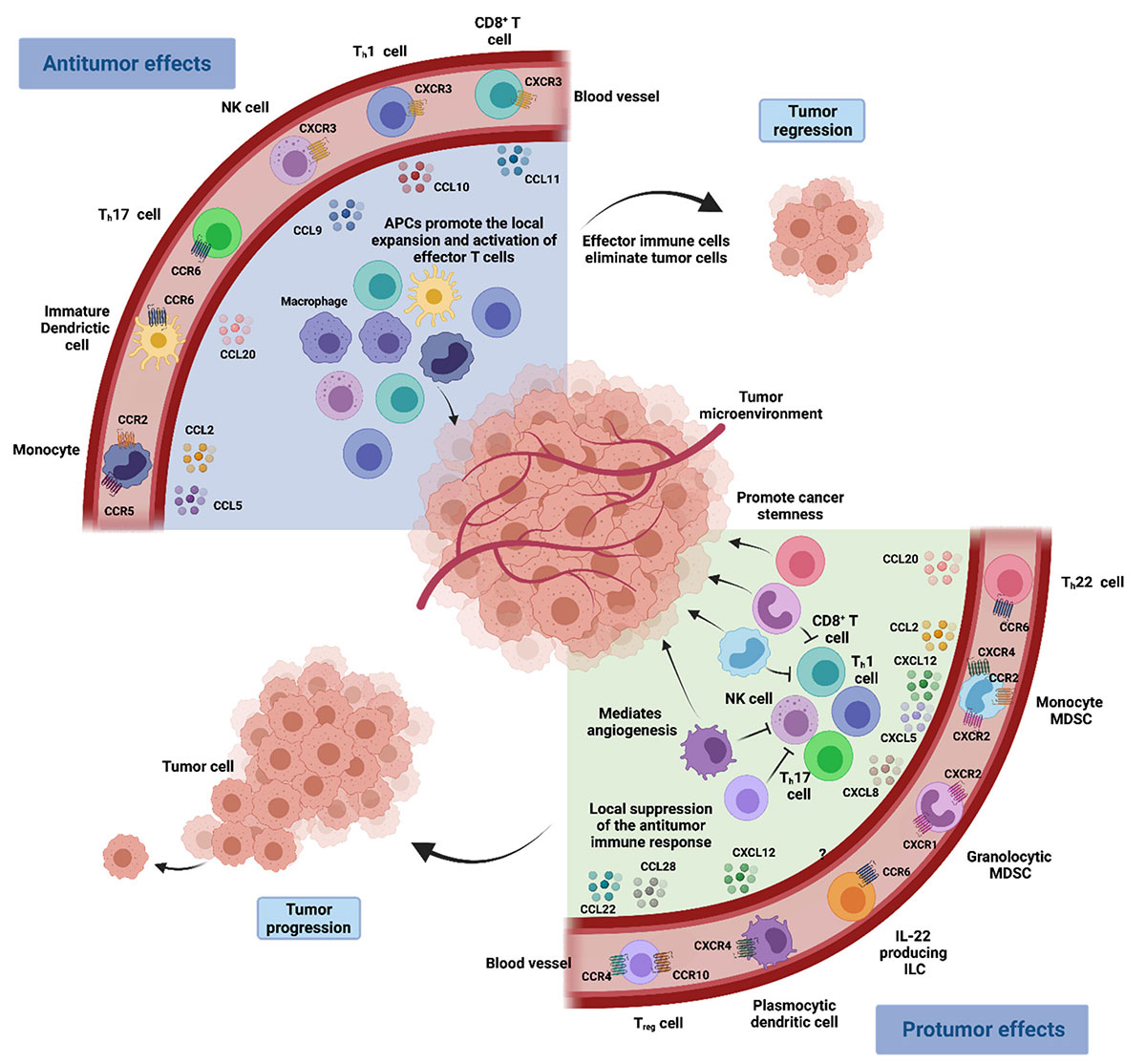
Chemokine network in the tumoral microenvironment immune response
Las quimiocinas son pequeñas citocinas o proteínas de señalización secretadas por las células. Según el número y la disposición de la L-cisteína (C) conservada en el extremo N-terminal, las quimiocinas pueden clasificarse en cuatro clases: C, CC, CXC y CX3C. Estas quimiocinas señalizan a través del receptor quimiocínico transmembrana de siete pasos de acoplamiento de proteína G en la superficie celular, que estimula la migración direccional celular. Las quimiocinas homeostáticas se expresan de forma constitutiva en condiciones fisiológicas y desempeñan un papel en la migración y la localización de las células, mientras que las quimiocinas inflamatorias se secretan rápidamente en los focos de inflamación, reclutando así células efectoras en los tejidos inflamados. Así pues, las quimiocinas desempeñan un papel central en el desarrollo y la homeostasis del sistema inmunitario y participan en la promoción de la activación, diferenciación, proliferación y apoptosis de las células inmunitarias y en todas las respuestas inmunitarias e inflamatorias protectoras o destructivas.
Además, la señalización por quimiocinas y la quimiotaxis de diversas poblaciones celulares también desempeñan un papel fundamental en el microambiente tumoral (MAT). En la MAT, muchas quimiocinas son liberadas por células inmunitarias, células tumorales y células asociadas a tumores. Estas quimiocinas pueden cambiar con el tiempo y el espacio, atrayendo diferentes tipos de células inmunitarias promotoras de tumores y antitumorales. La migración de las células inmunitarias influirá aún más en la progresión y metástasis de los tumores, y afectará directamente a la respuesta inmunitaria. Los estudios han revelado que las quimiocinas tienen funciones pleiotrópicas que afectan a las respuestas inmunitarias antitumorales y a la progresión tumoral. Teniendo esto en cuenta, en la última década se han establecido estrategias terapéuticas que utilizan o se dirigen a las quimiocinas, lo que ha llevado a probar muchos nuevos fármacos candidatos en ensayos clínicos. En particular, en las terapias basadas en quimiocinas, éstas son altamente redundantes en su unión a los receptores, el mismo receptor puede unirse a diferentes quimiocinas, y viceversa. Por lo tanto, sólo inhibiendo simultáneamente la quimiocina y su receptor con la misma función fisiológica se consigue que el efecto terapéutico sea más saludable y dure más tiempo.
ACROBiosystems ha desarrollado una serie de proteínas quimiocinas de las subfamilias CC, CXC y CX3C expresadas por HEK293. Los productos están disponibles en diversas especies y etiquetas. Además, basándonos en la plataforma tecnológica “FLAG”, desarrollamos receptores de quimiocinas de longitud completa, como CCR5, CCR8, CXCR3, CXCR4, CXCR5, CXCR6, etc., cuya elevada actividad biológica se verificó mediante la unión a anticuerpos. Nuestras proteínas recombinantes de la familia de las quimiocinas pueden acelerar sus programas de investigación científica y desarrollo de fármacos.
![]() Varias moléculas, especies y etiquetas
Varias moléculas, especies y etiquetas
![]() Alta pureza verificada por SDS-PAGE
Alta pureza verificada por SDS-PAGE
![]() Alta homogeneidad estructural verificada por SEC-MALS y DLS
Alta homogeneidad estructural verificada por SEC-MALS y DLS
![]() Alta actividad verificada por ELISA/SPR
Alta actividad verificada por ELISA/SPR
![]() Gran estabilidad y comodidad de almacenamiento y transporte
Gran estabilidad y comodidad de almacenamiento y transporte
| Molecule | Cat. No. | Species | Product Description | Preorder/Order |
|---|---|---|---|---|
| CCL1 | CC1-H82E9 | Human | Biotinylated Human CCL1 / I-309 / C-C motif chemokine 1 Protein, His,Avitag™ (MALS verified) | |
| CC1-H5254 | Human | Human CCL1 / I-309 Protein, Fc Tag (MALS verified) | ||
| CCL2 | CC2-H5255 | Human | Human CCL2 / MCP-1 Protein, Fc Tag (MALS verified) | |
| CCL3 | CC3-H5249 | Human | Human CCL3 / MIP-1 alpha Protein, His Tag | |
| CCL5 | CC5-H5251 | Human | Human CCL5/RANTES Protein, Fc Tag (MALS verified) | |
| CCL7 | CC7-H52H6 | Human | Human CCL7 / MCP-3 Protein, His Tag | |
| CCL14 | CC4-H5249 | Human | Human CCL14 / HCC-1 Protein, His Tag | |
| CCL17 | CC7-H5256 | Human | Human CCL17 / TARC Protein, Fc Tag (MALS verified) | |
| CCL22 | CC2-H5257 | Human | Human CCL22 / MDC Protein, Fc Tag | |
| CCL24 | CC4-H52H1 | Human | Human CCL24/Eotaxin-2 Protein, His Tag | |
| CXCL1 | CX1-H5253 | Human | Human CXCL1 Protein, Fc Tag | |
| CXCL4 | CX4-H52H9 | Human | Human CXCL4 / PF4 Protein, His Tag | |
| CXCL10 | CX0-H51H1 | Human | Human CXCL10 / IP-10 Protein, His Tag | |
| CXCL13 | CX3-H1249 | Human | Human CXCL13 / BCA-1 Protein, His Tag | |
| CXCL16 | CX6-H5254 | Human | Human CXCL16 Protein, Fc Tag | |
| CX3CL1 | CX1-H5221 | Human | Human CX3CL1 / Fractalkine Protein, His Tag | |
| CX1-H8221 | Human | Biotinylated Human CX3CL1 Protein, His Tag, ultra sensitivity (primary amine labeling) | ||
| CX1-C5222 | Cynomolgus | Cynomolgus CX3CL1 / Fractalkine Protein, His Tag | ||
| CXCR3 | CX3-H52P4 | Human | Human CXCR3 Full Length Protein-VLP | |
| CX3-H52D5 | Human | Human CXCR3 Protein, Flag,His Tag (Detergent) | ||
| CX3-M52P7 | Mouse | Mouse CXCR3 Full Length Protein (VLP) | ||
| CXCR4 | CX4-H5219 | Human | Human CXCR4 / CD184 Full Length Protein-VLP | |
| CX4-H5269 | Human | Human CXCR4 / CD184 Protein, Fc Tag | ||
| CXCR5 | CX5-H52P4 | Human | Human CXCR5 Full Length Protein-VLP | |
| CX5-H52D6 | Human | Human CXCR5 Protein, Flag,His Tag (Detergent) | ||
| CXCR6 | CX6-H52P3 | Human | Human CXCR6 / CD186 Full Length Protein (VLP) | |
| CCR4 | CC4-H52P3 | Human | Human CCR4 Full Length Protein (VLP) | |
| CCR5 | CC5-H52P3 | Human | Human CCR5 Full Length Protein-VLP | |
| CC5-H52P5 | Human | Fluorescent Human CCR5 Full Length Protein (VLP) | ||
| CC5-H52D1 | Human | Human CCR5 Protein, Flag,His Tag (Detergent) | ||
| CCR6 | CC6-H52P3 | Human | Human CCR6 Full Length Protein (VLP) | |
| CCR7 | CC7-H52P3 | Human | Human CCR7 Full Length Protein (VLP) | |
| CCR8 | CC8-H52P4 | Human | Human CCR8 Full Length Protein-VLP | |
| CC8-H52D6 | Human | Human CCR8 Protein, Flag,His Tag&Twin-Strep Tag (Detergent) |
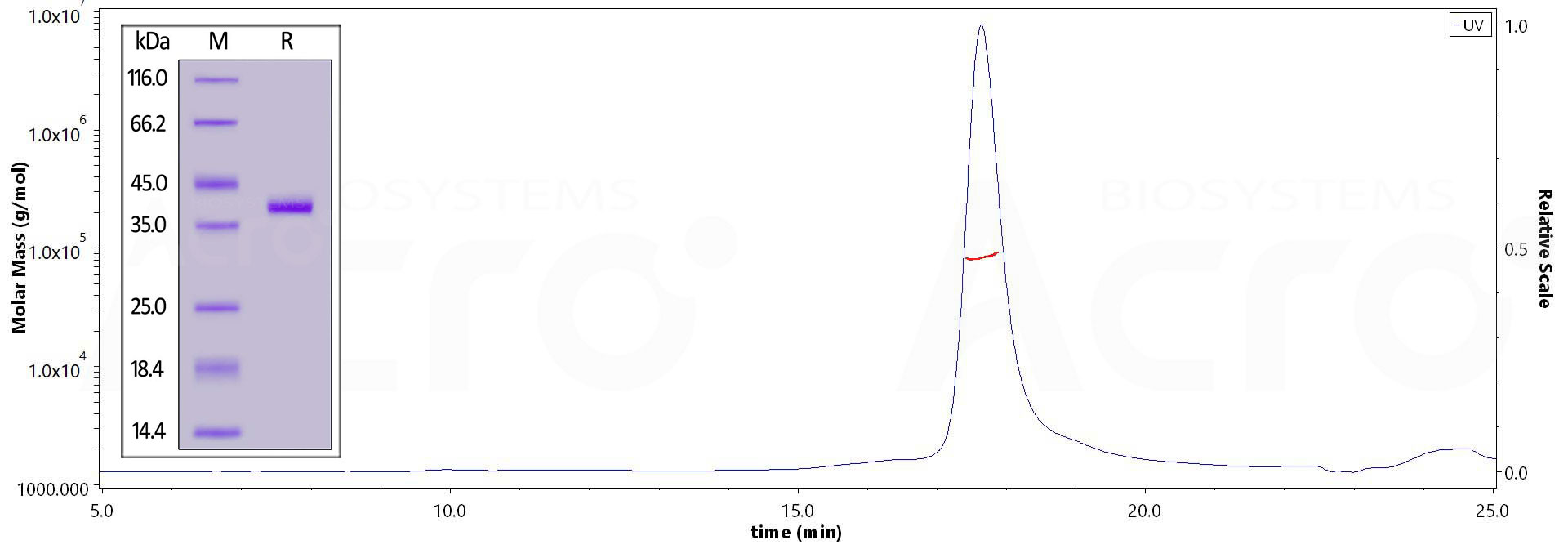
The purity of Human CCL5, Fc Tag (Cat. No. CC5-H5251) is more than 85% and the molecular weight of this protein is around 71-96 kDa verified by SEC-MALS.
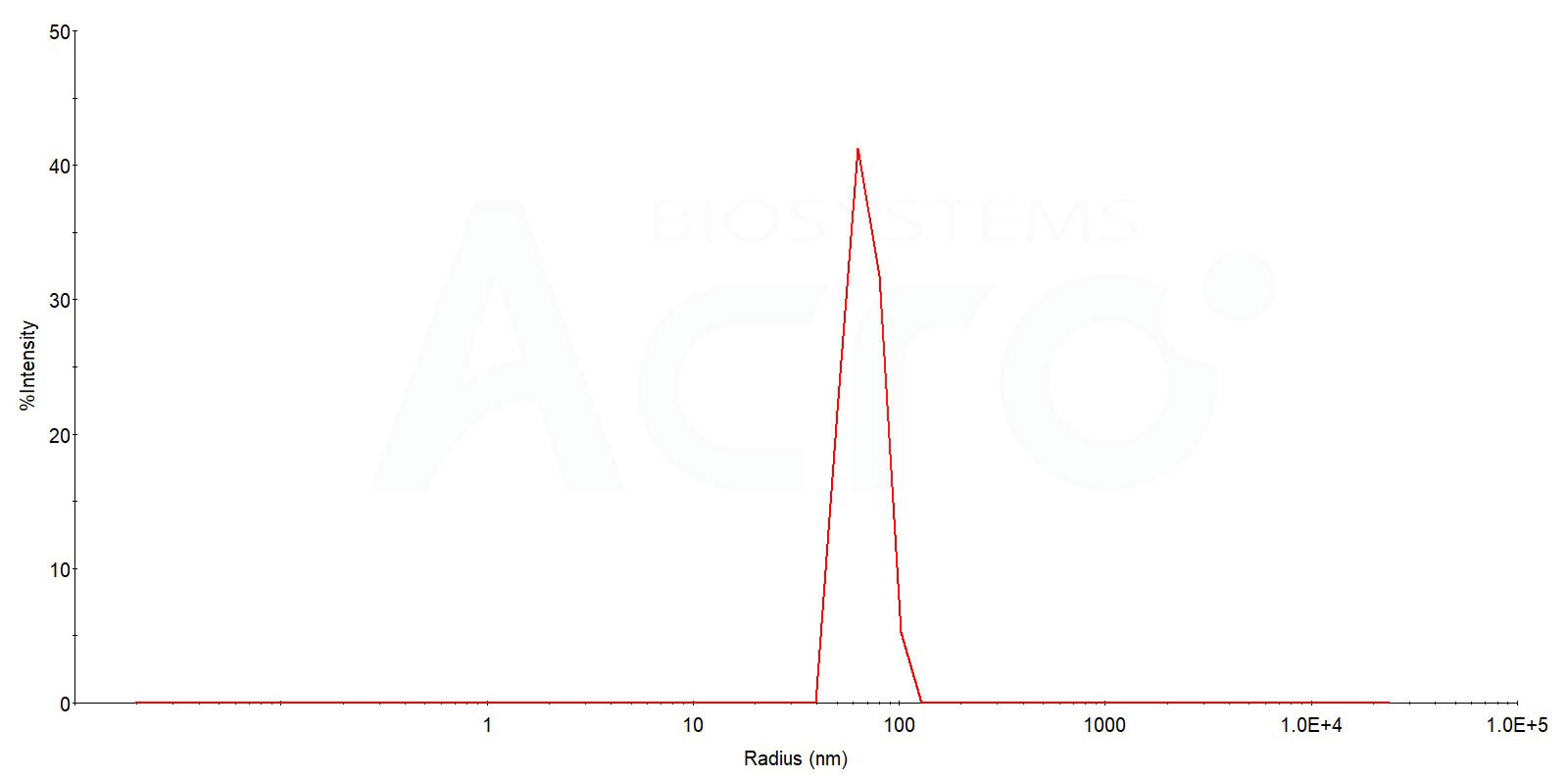
The mean peak Radius of VLP (Cat. No. CX3-H52P4) is 60-80 nm with more than 95% intensity as determined by dynamic light scattering (DLS).
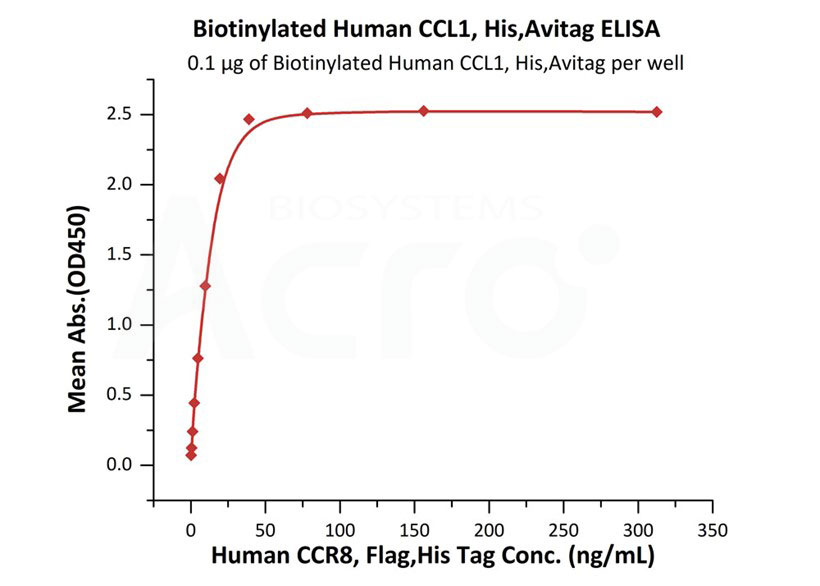
Immobilized Biotinylated Human CCL1, His,Avitag (Cat. No. CC1-H82E9) at 1 μg/mL (100 μL/well) on streptavidin (Cat. No. STN-N5116) precoated (0.5 μg/well) plate can bind Human CCR8, Flag,His Tag with a linear range of 0.3-39 ng/mL (QC tested).
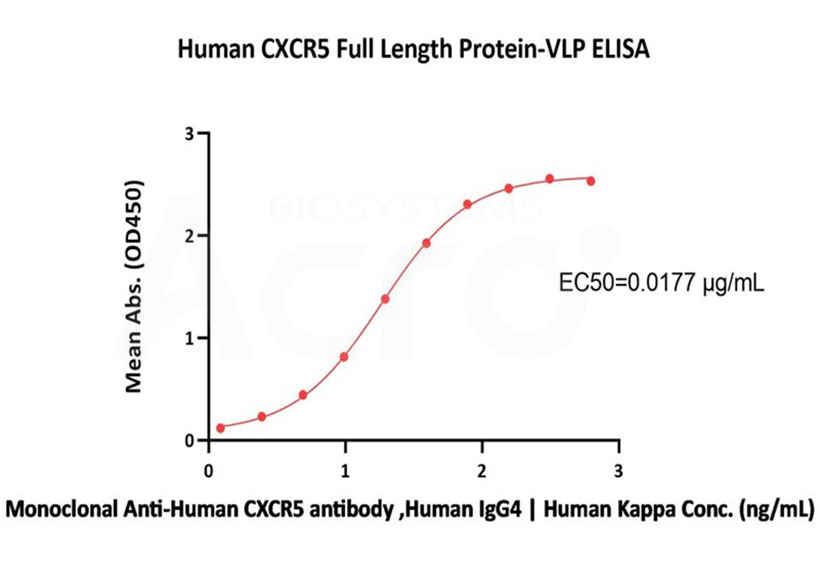
Immobilized Human CXCR5 Full Length Protein-VLP (Cat. No. CX5-H52P4) at 5 μg/mL (100 μL/well) can bind Monoclonal Anti-Human CXCR5 antibody, Human IgG4 | Human Kappa with a linear range of 1-78 ng/mL (QC tested).
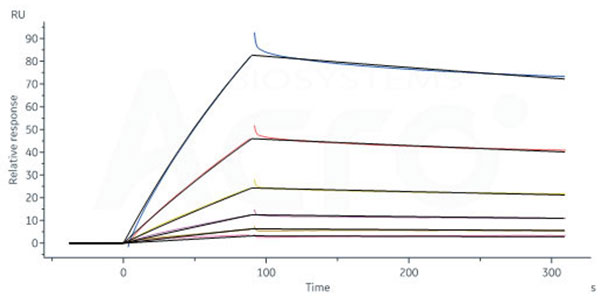
Anti-CXCR3 antibody immobilized on CM5 Chip can bind Human CXCR3 Full Length Protein-VLP (Cat. No. CX3-H52P4) with an affinity constant of 60.9 nM as determined in a SPR assay (Biacore 8K) (Routinely tested).
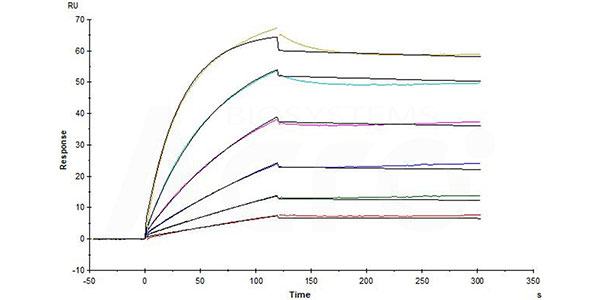
Human CCR5, Flag,His Tag (Cat. No. CC5-H52D1) captured on CM5 chip via anti-His antibody can bind Anti-CCR5 antibody (Human IgG1) with an affinity constant of 0.0737 nM as determined in a SPR assay (in presence of DDM and CHS) (Biacore T200).
This web search service is supported by Google Inc.
